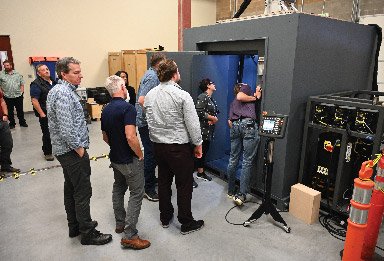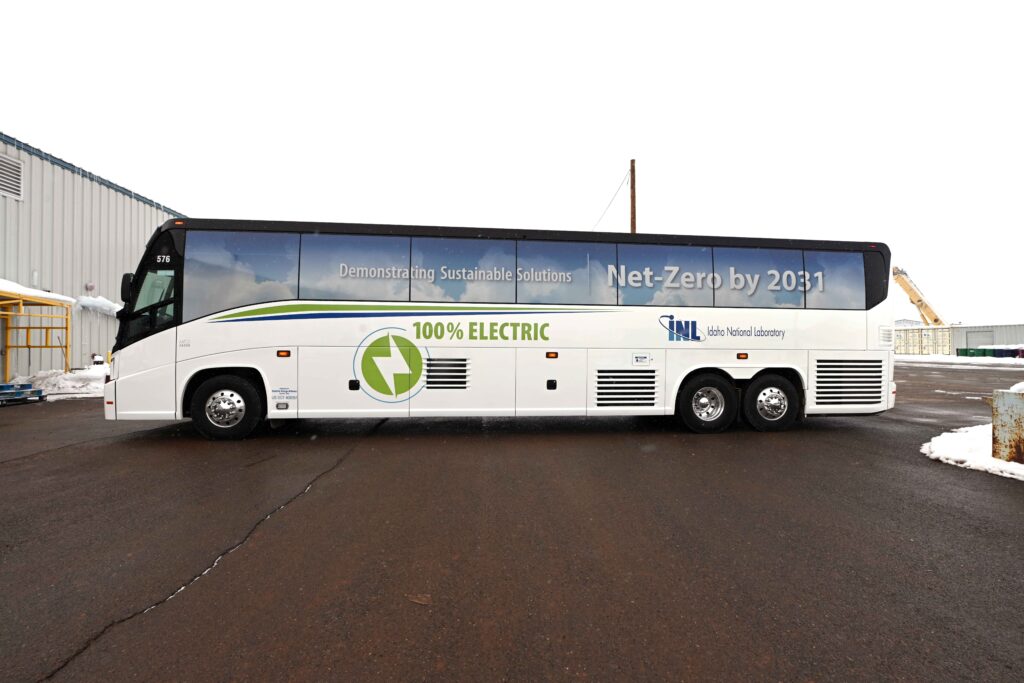R&D Impacts
FY23
Energy innovation starts here…
INL’s energy mission has always involved testing materials and defining parameters to safely operate reactors. Beyond nuclear, the lab’s mission encompasses renewable energy sources such as wind, hydro and bioenergy, electric vehicles, battery performance, and low-carbon production of fuels, advanced materials, and hydrogen. High-performance computing supports efforts in advanced modeling and simulation. The lab is a leading resource for cybersecurity and infrastructure and grid resilience.
Accomplishments and data are from fiscal year 2023.
Since 1977
in FY 23
Since 2005
Nuclear Energy Impacts

First-of-a-kind molten chloride salt experiment
For the first time in decades, researchers at Idaho National Laboratory synthesized and irradiated a molten chloride salt fueled with enriched uranium. The Molten Salt Research Temperature-Controlled Irradiation experiment was the first enriched uranium-fueled molten salt experiment since the Molten Salt Reactor Experiment at Oak Ridge National Laboratory in the 1960s. The experiment advances understanding of how fueled molten chloride salt coolants will perform in advanced reactor cores.

MARVEL microreactor achieves 90% design validation
DOE announced it had finished the final design report for the Microreactor Applications Research Validation and Evaluation Project, or MARVEL, the first new reactor being built at INL in more than 40 years. With this acceptance, MARVEL achieved 90% final design validation, which means the project can move forward with fabrication and construction. The 85-kilowatt sodium-potassium-cooled microreactor is planned to be located inside the Transient Reactor Test Facility building.

Three microreactor projects selected for DOME project at former EBR-II site
The iconic Experimental Breeder Reactor-II (EBR-II) containment structure is being repurposed as the Demonstration of Microreactor Experiments (DOME) project, a new test bed for higher thermal power reactor projects and small reactors. DOE chose three microreactor developers — Westinghouse, Radiant Nuclear and Ultra Safe Nuclear Corporation — to design the first experiments at DOME, which is expected to be ready for testing in 2026.

Study considers small modular reactors as energy source for EV charging
Small modular reactors, microreactors and hydrogen could be ideal to recharge electric semi-trucks, according to a University of Michigan study funded by Emerging Energy Markets Analysis, an INL-based initiative. Most EV studies assume electricity will always come from the electric grid. This was the first study to consider small modular reactors and other distributed energy resources as an energy source.

Quantum mechanics of nuclear fuels
As researchers discover new details about the laws that govern the tiniest building blocks of the universe, one area remains a mystery: the quantum mechanics of nuclear fuels. INL researchers are exploring quantum mechanics in actinides such as thorium and uranium with a new laboratory built around molecular beam epitaxy, a process that creates ultra-thin layers of materials with a high degree of purity.

Autonomous hot cell tool

MALAMUTE lets researchers think small
In the future, the biggest breakthroughs in aerospace and elemental energy will likely result from thinking small. Really small. A diverse group of Idaho National Laboratory researchers has created the MOOSE Application Library for Advanced Manufacturing Utilities (MALAMUTE), a simulation code designed to connect the microscale behavior of materials with their engineering-scale performance for a variety of advanced manufacturing processes.

Mobile supercomputers offer resiliency to data centers
Data centers consume large amounts of power, requiring giant backup generators and expensive battery systems. Idaho National Laboratory researchers have developed a novel approach to resiliency, offering mobile supercomputers in shipping containers that can be hooked up to renewable energy sources and small modular reactors. These “supercomputers-in-a-box” could someday serve as the basis for similar systems on the moon and Mars.
National Security Impacts

INL launches Cyber-Informed Engineering Resource Library

Nuclear response training continues to expand support

Storm-DEPART offers help to natural disaster victims
Each year, hurricanes and tropical storms damage critical infrastructure and disrupt services, affecting millions. To rapidly and accurately predict recovery estimations for critical infrastructure, Idaho National Laboratory and Entergy developed the Storm Damage Estimate Prediction and Recovery Tool (Storm-DEPART). Storm-DEPART combines critical infrastructure inventory data with weather forecasts to predict weather-related damages to a utility’s assets. It can estimate the time, materials and resources needed to restore normal operations.

OpDefender keeps watch over network traffic
OpDefender is a cybersecurity tool developed at Idaho National Laboratory that incorporates network switches to analyze and filter traffic network packets. Its proprietary software acts as a “smart” switch and its human-machine interface ensures that no device can communicate with a network until it has been configured by an operator. An alarm goes off by default when a network receives data transmitted from a device that has not been “whitelisted”.

Malcolm framework helps monitor remote infrastructure

New tool detects vulnerabilities in EVs, charging hardware

Mobile hot cell for radioactive source recovery
INL worked with the National Nuclear Security Administration’s Office of Radiological Security to develop a mobile hot cell that could be used to remove radiological source materials that might otherwise fall into the wrong hands. This will reduce global radiological threats by helping international partners improve radioactive source end-of-life management. Its robotics allow cell operators to stand a safe distance away from a source enabling safe, rapid deployment.

INL goes Down Under for Common Data Link demo
Common Data Link, or CDL, is a digital capability developed for common, standardized communication among airborne sensor data systems. It has been implemented on radios for airplanes, drones, ground facilities and ships. In summer 2023, INL supported the Launchpad Technology Demonstration Event, part of the Australian Defence Force’s biennial Talisman Sabre exercise, the largest combined training activity between Australia and the United States.
Energy & Materials Solutions Impacts

The world’s most complete biomass preprocessing R&D facility

Microgrid in a Box, demonstrated
The Relocatable Resiliency Alternative Power Improvement Distribution Microgrid in a Box is a portable microgrid system developed by INL that ensures a reliable and resilient power supply in remote or off-grid locations during emergency situations or power outages. It can be integrated with energy sources such as wind, solar, hydro, diesel and eventually microreactors. It made its debut in summer 2023 in Teton County, Idaho, paired with a rural hydropower plant.
Silicon carbide brake rotors for heavy duty trucks
Spark plasma sintering uses an electrical current rather than heat to fuse molecules, creating advanced materials capable of withstanding extreme heat, pressure and friction. Using its Electric Field Assisted Sintering (EFAS) machine, the DCS-800, INL has teamed with Carbon SiC Technologies to fabricate high-tech silicon carbide reinforced brake rotors for the U.S. Army’s large transport trucks.

National labs, industry participate in ChargeX Consortium

Clean energy pilot plants in Kuwait
Idaho National Laboratory and the U.S. Department of Defense are developing three clean energy demonstration projects for the U.S. Army Central Command in Kuwait, which currently gets 99% of its power from fossil fuels. Using advanced inverters, battery storage and specialized solar photovoltaic implementations, a U.S. Army program titled Operational Energy will diversify the area’s energy economy and improve the quality of life for service men and women by eliminating diesel fumes and noise.

Industrial-scale hydrogen production technologies offered

First INL electric motor coach enters service
Idaho National Laboratory reached a milestone in 2023 with the addition of its first electric motor coach. The lab collaborated with Motor Coach Industries and Bergstrom, a manufacturer of climate systems for commercial vehicles, to produce the EClimaCoach, which features the only EV no-idle HVAC system. INL researchers work with the lab’s Fleet Services department to demonstrate best practices for other municipalities and organizations looking to adopt electric motorcoaches.
Previous R&D Impacts
Not finding what you are looking for? Please send your question to [email protected].


